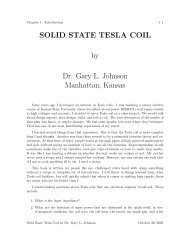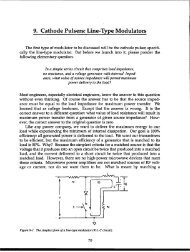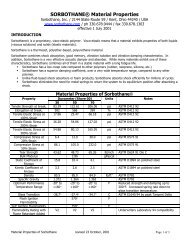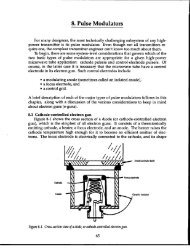3.6M north10.pdf - Dean-O's Toy Box
3.6M north10.pdf - Dean-O's Toy Box
3.6M north10.pdf - Dean-O's Toy Box
You also want an ePaper? Increase the reach of your titles
YUMPU automatically turns print PDFs into web optimized ePapers that Google loves.
154 High-Power Microwave-Tube Transmitters<br />
later is almost always the most expensive, if not always the largest.<br />
Before leaving the high-power output-pulse transformer behind, it would be<br />
negligent not to discuss its use in a hard-tube modulator that has a diode-type, or<br />
unidirectional, conduction (de) load. We have already mentioned what can be<br />
done with energy stored in the transformer magnetizing inductance when used<br />
in a line-type modulator. So long as the switch tube is still in the forwardconduction<br />
state, the energy will manifest itself as reverse voltage on the pulseforming<br />
network. This is not possible in a hard-tube modulator, because the<br />
means of terminating a pulse is to stop switch-tube conduction. This situation<br />
leaves no place for the flow of current, which has built up in the magnetizing<br />
inductance over the course of the pulse. For this reason, a back-swing clipper<br />
circuit, as shown in Fig. 10-4, is required. Without it, the voltage across the<br />
transformer primaxy will jump up at the end of the pulse in a direction that<br />
increases the forward voltage across the switch tube (just as it is trying to recover<br />
its voltage-blocking state and after its electrodes have been heated to their maximum<br />
transient temperatures). The result will be a switch-tube arc. The clipper<br />
circuit provides a path for the magnetizing current after the switch tube is cut off.<br />
This clipper current can be defined as<br />
.<br />
‘clipper<br />
=<br />
J<br />
lMe-tRCILM – lbiLhf<br />
4’<br />
where RC is the clipper resistance, LM is the transformer magnetizing inductance,<br />
and lM is the peak value of magnetizing current that occurs at the end of the<br />
pulse of voltage applied to the transformer. The energy stored in the transformer<br />
magnetizing inductance, WM, can be defined as<br />
where Vp is the voltage pulse output of the switch tube and z is the pulse length.<br />
There will still be a transient overvoltage due to the clipper resistance in<br />
series with the clipper diode. Without series resistance, the clipper time-constant<br />
could theoretically be infinite because it is LM/Rc. The greater the value of Rc,<br />
the shorter the recovery time will be but the greater will be the peak reverse<br />
voltage. The volt-time products across a transformer winding must be equal in<br />
the positive-going and negative-going polarities. If they are not, the result is<br />
time-averaged voltage across the winding-which ultimately is just a length of<br />
wire-and it is difficult to maintain average voltage across it. The larger the<br />
value of clipper resistance, the shorter the decay time of magnetizing current but<br />
the greater the transient overvoltage, which is equal to IM x Rc. There can be an<br />
advantage to using a non-linear resistance such as Thyrite, or the more modern<br />
metal-oxide varistor (MOV), as the clipper load . A properly selected non-linear<br />
resistance will have nearly constant voltage across it throughout the interpulse<br />
interval, thus minimizing the stress on the switch tube immediately following the







